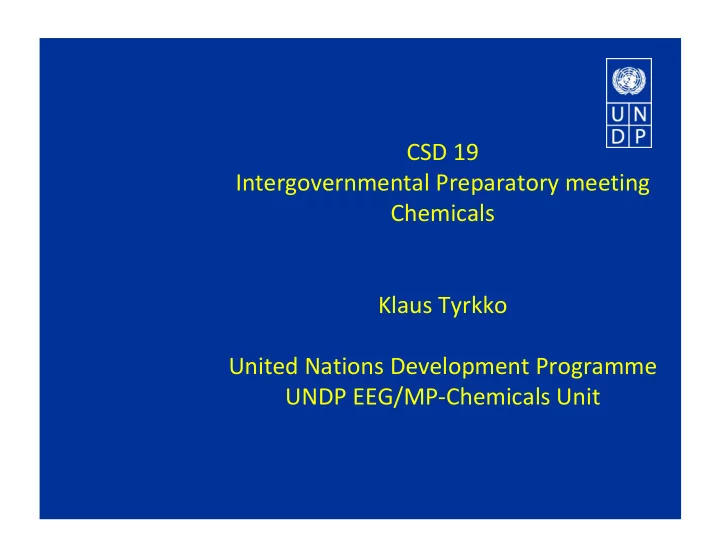

CSD 19 Intergovernmental Preparatory meeting Chemicals Klaus Tyrkko United Nations Development Programme UNDP EEG/MP-Chemicals Unit
Structure of the presentation 1. Strengthening governance on chemicals management at the national level 2. How to implement the life-cycle approach in enhancing chemical safety 3. How to secure the financial resources for sound management of chemicals at all levels
Chemicals Governance • Good Chemicals governance approaches is no different than general Good governance • Regulatory basis (substance specific regulations directly on base Environmental law, convention driven) • Roles and interaction between line ministries in chemicals intensive sectors. • Implementation and enforcement capacity
Chemicals Governance Lack of Good governance is major culprit of chemical management issues e.g. - Marketing of unauthorized chemicals - Possibilities to circumvent regulations/inspection - Transboundary movements of chemicals and waste (export and import) - Unsuccessful implementation of sound approaches such as economic instruments.
Chemicals Governance Way forward: 1. Traditional institutional and skills capacity building for chemicals management still important. 2. The capacity building need to complemented by training on setting up schemes for ensuring good governance as regulatory and control schemes become more complicated 3. Introduce systematically good governance tools (SEA, economic CBA)
How to implement the life-cycle approach in enhancing chemical safety Several reasons exist for difficulties in ensuring life cycle approaches are followed: 1. Lack of information on chemical and products properties and risks 2. Global Conventions have unfortunately not always included full lifecycle approaches (Basel, Rotterdam, Vienna/Montreal) 3. Recycling possibilities not considered in the design of products
How to implement the life-cycle approach in enhancing chemical safety Approaches for ensuring better chemicals safety throughout the life-cycle 1. Information sharing: GHS , chemicals risk evaluations 2. Strategic Environmental Assessment (SEA) with chemicals and contaminants criteria e .g. in Agriculture, Extractive, Industrial, Trade sectors.
How to implement the life-cycle approach in enhancing chemical safety Approaches ….( cont) 3 . Further continue and intensify the cooperation between Global Chemicals related Conventions and particularly their implementation at national level in order to ensure life-cycle approaches . 4. Ensure information (requirements) on product components/materials and appropriate recycling.
How to secure the financial resources for sound management of chemicals at all levels Recent discussions on financing chemicals and waste has concentrated some approaches to consider – Industry involvement, including public-private partnerships and the use of economic instruments at national and international levels; – New trust fund similar to the Multilateral Fund; and – Introducing safe chemicals and wastes management as a new focal area, expanding the existing Chemicals focal area under GEF or establishing a new trust fund under GEF – Mainstreaming of sound management of chemicals and hazardous wastes sector and development plans;
Mainstreaming of chemicals What is chemicals mainstreaming into development plans? A strategy for translating health and environmental effects of unsound management of chemicals into a language that is being understood by development and finance ministries. Integration of SMC related priorities into a country’s development plans, but also into sector strategies, local level implementation and programmes .
�������������������������� Why: To ensure a broader financial basis for sound management of chemicals by fostering national budget commitments as well as International support for chemicals management And subsequently identifying the policies and programmes needed to bring about pro-poor chemicals management.
�������������������������� Relevance to financing: � Brings new resources for sound chemicals management as more partners are involved (development practitioners, private sector) � The demonstration of efficient and cost-effective use of resources facilitates the mobilization of new and additional development assistance
�������������������������� Relevance for securing financial resources for SMC: � Use of economic and other innovative instruments as a way to mobilize new and additional financing from the private sector (cost sharing) � Development of integrated (cross-sectoral) solutions for preventive chemicals management. � Function as platform and catalyst for combining and sequencing available grant, public and private resources for tackling such integrated solutions.
�������������������������� How: Guidance materials and tools developed based on SMC mainstreaming methodology UNDP/UNEP SMC Mainstreaming projects have been developed and funded for 12 pilot countries: Belarus, Belize, Cambodia, Ecuador, Honduras, Laos PDR, Liberia, FYR Macedonia, Mauritania, Mauritius, Uganda & Zambia
Thank you !
Recommend
More recommend